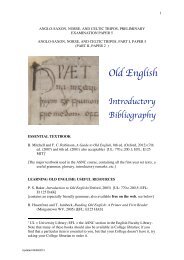Scandinavian history in the Viking age - Department of Anglo-Saxon ...
Scandinavian history in the Viking age - Department of Anglo-Saxon ...
Scandinavian history in the Viking age - Department of Anglo-Saxon ...
You also want an ePaper? Increase the reach of your titles
YUMPU automatically turns print PDFs into web optimized ePapers that Google loves.
<strong>Scand<strong>in</strong>avian</strong> History <strong>in</strong> <strong>the</strong> Vik<strong>in</strong>g Age<br />
conquest <strong>of</strong> England, but also occasionally conta<strong>in</strong> stray remarks about Scand<strong>in</strong>avia itself. Only a few <strong>of</strong><br />
<strong>the</strong> major sources are listed here.<br />
[B110] William <strong>of</strong> Jumièges f<strong>in</strong>ished his Gesta Normannorum ducum ‘Deeds <strong>of</strong> <strong>the</strong> dukes <strong>of</strong><br />
Normandy’ <strong>in</strong> <strong>the</strong> early 1070s; it provides <strong>the</strong> sole evidence for sa<strong>in</strong>t Olaf Haraldsson’s baptism <strong>in</strong><br />
Rouen. Text and transl.: E.M.C. van Houts, The Gesta Normannorum ducum <strong>of</strong> William <strong>of</strong> Jumièges,<br />
Orderic Vitalis, and Robert <strong>of</strong> Torigni, 2 vols (1992-95) [UL 716:01.c.2.79-80]<br />
[B111] William <strong>of</strong> Malmesbury is def<strong>in</strong>itely one <strong>of</strong> <strong>the</strong> most important <strong>Anglo</strong>-Norman historians, not<br />
only <strong>in</strong> terms <strong>of</strong> <strong>the</strong> breadth <strong>of</strong> his work but also because he seems to have had access to many source<br />
materials now lost; he was active <strong>in</strong> <strong>the</strong> first half <strong>of</strong> <strong>the</strong> twelfth century. [a] His Gesta regum <strong>Anglo</strong>rum<br />
‘Deeds <strong>of</strong> <strong>the</strong> k<strong>in</strong>gs <strong>of</strong> <strong>the</strong> English’ conta<strong>in</strong>s a full account <strong>of</strong> <strong>the</strong> reign <strong>of</strong> Æ<strong>the</strong>lstan (924-39), where it<br />
mentions relations with a k<strong>in</strong>g Harald (presumably Harald fairhair (E30 ff.) <strong>of</strong> Norway). Text and transl.:<br />
R.A.B. Mynors et al., William <strong>of</strong> Malmesbury, Gesta regvm <strong>Anglo</strong>rvm: <strong>the</strong> <strong>history</strong> <strong>of</strong> <strong>the</strong> English k<strong>in</strong>gs, 2<br />
vols (1998-99) [UL 716:01.c.2.94-95]; <strong>the</strong> relevant excerpts can be found <strong>in</strong> (B81):303-10. [b] His<br />
<strong>history</strong> <strong>of</strong> <strong>the</strong> abbey <strong>of</strong> Glastonbury is also surpris<strong>in</strong>gly <strong>in</strong>terest<strong>in</strong>g, <strong>in</strong> that it conta<strong>in</strong>s an obituary list <strong>of</strong><br />
bishops from <strong>the</strong> reign <strong>of</strong> k<strong>in</strong>g Edgar (959-75) which mentions one Sigfrid ‘bishop <strong>of</strong> Norway’. Text and<br />
transl.: J. Scott, The early <strong>history</strong> <strong>of</strong> Glastonbury: an edition, translation and study <strong>of</strong> William <strong>of</strong><br />
Malmesbury’s De antiquitate Glastonie ecclesie (1981) [UL 479:7.c.95.46]; cf. also (L40)<br />
[B112] John <strong>of</strong> Worcester wrote his Chronicon ex chronicis (formerly attributed to Florence <strong>of</strong><br />
Worcester) around 1140, and provides some extra material on <strong>the</strong> period <strong>of</strong> <strong>the</strong> <strong>Anglo</strong>-Danish k<strong>in</strong>gs <strong>in</strong><br />
particular. Text and transl.: P. McGurk et al., The chronicle <strong>of</strong> John <strong>of</strong> Worcester. II: The annals from<br />
450 to 1066 (1995) [UL 716:01.c.2.86]; fur<strong>the</strong>r excerpts transl. <strong>in</strong> (B81):310-19 (on <strong>the</strong> <strong>Anglo</strong>-Danish<br />
k<strong>in</strong>gs), (B82):215-28<br />
[B113] Orderic Vitalis wrote his epic Historia ecclesiastica <strong>in</strong> <strong>the</strong> early twelfth century; it conta<strong>in</strong>s<br />
some useful observations on <strong>Scand<strong>in</strong>avian</strong> <strong>history</strong>, particularly dur<strong>in</strong>g <strong>the</strong> eleventh century. Text and<br />
transl.: M. Chibnall, The ecclesiastical <strong>history</strong> <strong>of</strong> Orderic Vitalis, 6 vols (1969-80) [UL 716:01.c.2.28-33]<br />
Celtic sources<br />
Sources from <strong>the</strong> Celtic-speak<strong>in</strong>g areas <strong>of</strong> Scotland, Ireland, and Wales are naturally most <strong>in</strong>formative on<br />
<strong>the</strong> Vik<strong>in</strong>gs abroad <strong>in</strong> <strong>the</strong> British isles, yet <strong>the</strong>y also occasionally provide extra <strong>in</strong>formation on <strong>the</strong><br />
<strong>Scand<strong>in</strong>avian</strong> background. The Irish sources are particularly strik<strong>in</strong>g <strong>in</strong> <strong>the</strong>ir rare ability (or simply<br />
will<strong>in</strong>gness) to dist<strong>in</strong>guish Danes from Norwegians through <strong>the</strong> contrast between Dubgaill ‘Black<br />
foreigners’ referr<strong>in</strong>g to <strong>the</strong> former and F<strong>in</strong>ngaill ‘White foreigners’ for <strong>the</strong> latter. On <strong>the</strong> o<strong>the</strong>r hand, <strong>the</strong>y<br />
frequently tend to be disappo<strong>in</strong>t<strong>in</strong>gly reticent on <strong>the</strong> fate <strong>of</strong> <strong>the</strong> Vik<strong>in</strong>g colonies <strong>in</strong> <strong>the</strong> nor<strong>the</strong>rn and<br />
western isles <strong>of</strong> Scotland, where <strong>Scand<strong>in</strong>avian</strong> culture took root most firmly <strong>in</strong> Brita<strong>in</strong>. Only a selection<br />
<strong>of</strong> sources from <strong>the</strong> Celtic-speak<strong>in</strong>g areas has been <strong>in</strong>cluded here; for fur<strong>the</strong>r guidance, see (I240) and<br />
(B125).<br />
Anthologies<br />
[B120] A.O. Anderson, Early sources <strong>of</strong> Scottish <strong>history</strong> A.D. 500 to 1286, 2 vols, rev. by M. Anderson,<br />
Paul Watk<strong>in</strong>s medieval studies 1 (1990) [UL 550:4.c.95.37-38]; conta<strong>in</strong>s a wide collection <strong>of</strong> primary<br />
sources relat<strong>in</strong>g to Scotland, all <strong>in</strong> English translation<br />
Guides<br />
[B122] K. Hughes, Early Christian Ireland: <strong>in</strong>troduction to <strong>the</strong> sources, The sources <strong>of</strong> <strong>history</strong>: studies<br />
<strong>in</strong> <strong>the</strong> uses <strong>of</strong> historical evidence (1972) [UL 554:6.c.95.3]<br />
[B123] R.I. Jack, Medieval Wales, The sources <strong>of</strong> <strong>history</strong>: studies <strong>in</strong> <strong>the</strong> uses <strong>of</strong> historical evidence<br />
(1972) [UL 485:2.c.95.27]<br />
For a survey <strong>of</strong> Irish perceptions and presentations <strong>of</strong> <strong>the</strong> Vik<strong>in</strong>gs <strong>in</strong> a wide range <strong>of</strong> sources:<br />
[B125] M. Ní Mhaonaigh, ‘Friend and foe: Vik<strong>in</strong>gs <strong>in</strong> n<strong>in</strong>th- and tenth-century Irish literature’,<br />
(O82):381-402<br />
15






